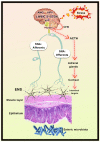Clinical and Preclinical Studies of Fermented Foods and Their Effects on Alzheimer's Disease
- PMID: 35624749
- PMCID: PMC9137914
- DOI: 10.3390/antiox11050883
Clinical and Preclinical Studies of Fermented Foods and Their Effects on Alzheimer's Disease
Abstract
The focus on managing Alzheimer's disease (AD) is shifting towards prevention through lifestyle modification instead of treatments since the currently available treatment options are only capable of providing symptomatic relief marginally and result in various side effects. Numerous studies have reported that the intake of fermented foods resulted in the successful management of AD. Food fermentation is a biochemical process where the microorganisms metabolize the constituents of raw food materials, giving vastly different organoleptic properties and additional nutritional value, and improved biosafety effects in the final products. The consumption of fermented foods is associated with a wide array of nutraceutical benefits, including anti-oxidative, anti-inflammatory, neuroprotective, anti-apoptotic, anti-cancer, anti-fungal, anti-bacterial, immunomodulatory, and hypocholesterolemic properties. Due to their promising health benefits, fermented food products have a great prospect for commercialization in the food industry. This paper reviews the memory and cognitive enhancement and neuroprotective potential of fermented food products on AD, the recently commercialized fermented food products in the health and food industries, and their limitations. The literature reviewed here demonstrates a growing demand for fermented food products as alternative therapeutic options for the prevention and management of AD.
Keywords: Alzheimer’s disease; fermented foods; gut microbiota; memory and cognition; neuroprotection; oxidative stress; probiotics.
Conflict of interest statement
The authors declare no conflict of interest.
Figures



Similar articles
-
Kefir and Its Biological Activities.Foods. 2021 May 27;10(6):1210. doi: 10.3390/foods10061210. Foods. 2021. PMID: 34071977 Free PMC article. Review.
-
Does a pickle a day keep Alzheimer's away? Fermented food in Alzheimer's disease: A review.Exp Gerontol. 2023 Dec;184:112332. doi: 10.1016/j.exger.2023.112332. Epub 2023 Nov 21. Exp Gerontol. 2023. PMID: 37967591 Review.
-
Effects of Phytochemicals from Fermented Food Sources in Alzheimer's Disease In Vivo Experimental Models: A Systematic Review.Foods. 2023 May 23;12(11):2102. doi: 10.3390/foods12112102. Foods. 2023. PMID: 37297345 Free PMC article. Review.
-
Health benefits of fermented foods: microbiota and beyond.Curr Opin Biotechnol. 2017 Apr;44:94-102. doi: 10.1016/j.copbio.2016.11.010. Epub 2016 Dec 18. Curr Opin Biotechnol. 2017. PMID: 27998788 Review.
-
Health benefits of fermented foods.Crit Rev Food Sci Nutr. 2019;59(3):506-527. doi: 10.1080/10408398.2017.1383355. Epub 2017 Oct 20. Crit Rev Food Sci Nutr. 2019. PMID: 28945458 Review.
Cited by
-
The Survival of Psychobiotics in Fermented Food and the Gastrointestinal Tract: A Review.Microorganisms. 2023 Apr 11;11(4):996. doi: 10.3390/microorganisms11040996. Microorganisms. 2023. PMID: 37110420 Free PMC article. Review.
-
Exploring the potential of probiotics in Alzheimer's disease and gut dysbiosis.IBRO Neurosci Rep. 2024 Nov 8;17:441-455. doi: 10.1016/j.ibneur.2024.11.004. eCollection 2024 Dec. IBRO Neurosci Rep. 2024. PMID: 39629018 Free PMC article. Review.
-
Antioxidants and Anti-Inflammatory Effects in Neurodegenerative Diseases (NDs).Antioxidants (Basel). 2022 Jun 14;11(6):1172. doi: 10.3390/antiox11061172. Antioxidants (Basel). 2022. PMID: 35740069 Free PMC article.
-
Prediction of Alzheimer's Disease by a Novel Image-Based Representation of Gene Expression.Genes (Basel). 2022 Aug 8;13(8):1406. doi: 10.3390/genes13081406. Genes (Basel). 2022. PMID: 36011317 Free PMC article.
-
Sourdough bread as nutritional intervention tool for improvement of cognitive dysfunction in diabetic rats.BMC Nutr. 2024 Mar 26;10(1):53. doi: 10.1186/s40795-024-00861-x. BMC Nutr. 2024. PMID: 38528644 Free PMC article.
References
-
- WHO|Dementia. [(accessed on 22 February 2018)]; Available online: http://www.who.int/mediacentre/factsheets/fs362/en/
-
- International A.D., Guerchet M., Prince M., Prina M. Numbers of People with Dementia Worldwide: An Update to the Estimates in the World Alzheimer Report 2015. 2020. [(accessed on 1 April 2022)]. Available online: https://www.alzint.org/resource/numbers-of-people-with-dementia-worldwide/
-
- Nichols E., Vos T. Estimating the Global Mortality from Alzheimer’s Disease and Other Dementias: A New Method and Results from the Global Burden of Disease Study 2019. Alzheimer’s Dement. 2020;16:e042236. doi: 10.1002/alz.042236. - DOI
Publication types
Grants and funding
LinkOut - more resources
Full Text Sources

